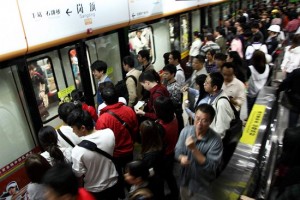With the outrage over the boy squatting on the GZ metro, are attitudes changing?
Posted: 11/20/2012 7:00 am I’ll never forget taking the train between Tianjin and Beijing, back in 2007, a year before the fancy high-speed rail linking the two cities was launched. I was late to buying a ticket, so was stuck with standing-room only. The train was absolutely packed: the seats were filled with people in thick down coats, the windows were steamed up, luggage was hanging from the overhead bins, bags cluttered the aisles and exits, and people were draped around the luggage and squeezed into whatever spots they could find. That’s when I realized I was standing in a warm puddle of liquid sloshing around, soaking my shoes and the luggage that was sitting on the floor.
I’ll never forget taking the train between Tianjin and Beijing, back in 2007, a year before the fancy high-speed rail linking the two cities was launched. I was late to buying a ticket, so was stuck with standing-room only. The train was absolutely packed: the seats were filled with people in thick down coats, the windows were steamed up, luggage was hanging from the overhead bins, bags cluttered the aisles and exits, and people were draped around the luggage and squeezed into whatever spots they could find. That’s when I realized I was standing in a warm puddle of liquid sloshing around, soaking my shoes and the luggage that was sitting on the floor.
Yes, a kid had decided to urinate on the floor, either on his/her own or at the behest of his/her parents. The thing is, I noticed it and picked up my backpack (I didn’t want it soaked in pee), but nobody else really seemed to pay much mind. During my early days in Beijing, I saw other kids pee on the Beijing metro; it wasn’t a regular occurrence, but I saw it a handful of times over my three years in the city. Fast forward five years later to November 10, 2012, and the outrage over a boy spotted squatting on a metro train in Guangzhou. There are five years between these two incidents, which is an eternity in China time, but have attitudes really changed that much? It seems so.
The image of a boy defecating on the Guangzhou public metro has outraged the people of Guangzhou, with several vile comments circulating on Sina Weibo. Indeed, it appears people in China – at least in the bigger, more developed locales – are becoming less tolerant of certain kinds of behaviour. In this case, though, anger also appears to be directed at the operator of Guangzhou’s metro network.
It turns out that of Guangzhou’s more than 100 metro stations, only 16 come fully equipped with toilets. The lack of proper restrooms has long been a complaint among Guangzhou’s commuters, and the image of the boy squatting on a moving train is serving as a catalyst to once again call for more facilities. Here’s the China Daily‘s take:
An official from Guangzhou Metro who did not want to be identified said the company has been urged to have the plans for new stations include toilets to help ease the shortage.
“Many deputies of the city people’s congress, members of local committees of the Chinese People’s Political Consultative Conference and residents have suggested we install mobile toilets near metro stations to deal with the problem, and we are discussing such a plan,” he added.
Meanwhile, the corporation is trying to guide passengers to use the public restrooms near metro stations, he said.
Han Zhipeng, a member of the CPPCC Guangzhou committee, wrote on his micro blog that the subway station should give commuters access to staff toilets upon request.
Here’s the thing, though: Hong Kong’s MTR doesn’t come equipped with toilets at its stations either, yet you don’t see people taking a dump on moving trains there. (The KCR’s East Rail Line and West Rail Line had toilets prior to merging with the MTR, so those toilets remain; however there are no toilets at urban line stations on the MTR’s network).
Indeed, there should be toilet facilities at stations, although this correspondent is aware that retrofitting stations with toilets is not an easy task. There are usually space constraints and problems connecting with existing sewer systems. As a secondary option, there should be clear signs to nearby toilets (in shopping malls, restaurants, or public toilets near exits) or staff should make passengers aware they can use staff toilets upon request.
So while the Guangzhou metro needs to do more, this won’t be the last time a boy urinates or defecates on a moving train in China no matter how many public toilets are nearby. This is a societal issue more than a toilet issue. But with the proliferation of smartphones and emergence of Sina Weibo, it’s much harder for these kinds of acts to go unnoticed… or unpublished.

 1
1














